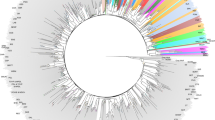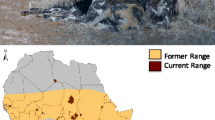Abstract
The raccoon dog (Nyctereutes procyonoides) has a wide distribution in Europe and is a prominent example of a highly adaptable alien species. It has been recorded sporadically in Denmark since 1980 but observations since 2008 suggested that the species had established a free-ranging, self-sustaining population. To elucidate the origin and genetic patterns of Danish raccoon dogs, we studied the population genomics of 190 individuals collected in Denmark (n = 141) together with reference captive individuals from Poland (n = 21) and feral individuals from different European localities (Germany, Poland, Estonia and Finland, n = 28). We used a novel genotyping-by-sequencing approach simultaneously identifying and genotyping a large panel of single nucleotide polymorphisms (n = 4526). Overall, there was significant indication for contemporary genetic structuring of the analysed raccoon dog populations, into at least four different clusters, in spite of the existence of long distance gene flow and secondary admixture from different population sources. The Danish population was characterized by a high level of genetic admixture with neighbouring feral European ancestries and the presence of private clusters, non-retrieved in any other feral or captive populations sampled. These results suggested that the raccoon dog population in Denmark was founded by escapees from genetically unidentified Danish captive stocks, followed by a recent admixture with individuals migrating from neighbouring Germany.





Similar content being viewed by others
References
Abdelkrim J, Pascal M, Calmet C, Samadi S (2005) Importance of assessing population genetic structure before eradication of invasive species: examples from insular Norway rat populations. Conserv Biol 19:1509–1518. doi:10.1111/j.1523-1739.2005.00206.x
Alexander DH, Novembre J, Lange K (2009) Fast model-based estimation of ancestry in unrelated individuals. Genome Res 19:1655–1664. doi:10.1101/gr.094052.109
Allendorf, Lundkvist (2003) Introduction: population biology, evolution, and control of invasive species. Conserv Biol 17:24–30
Anonymous (2015) Order regarding housing of specific animals (in Danish: Bekendtgørelse om forbud mod hold af særlige dyr, bek. nr. 1261 af 17/11/2015)
Ansorge H, Ranyuk M, Kauhala K et al (2009) Populations in the area of origin and in colonised regions—the epigenetic variability of an immigrant. Ann Zool Fenn 46:51–62. doi:10.5735/086.046.0106
Asferg T (1991) Danmarks Pattedyr 2. Gyldendal, Copenhagen
Baagøe HJ, Ujvári M (2007) Mårhund. Dansk Pattedyratlas. Gyldendal, Copenhagen, pp 182–183
Cushman SA (2015) Pushing the envelope in genetic analysis of species invasion. Mol Ecol. doi:10.1111/mec.13043
Danish Environmental Ministry (2010) Indsatsplan mod mårhund i Danmark, Copenhagen
Davey JW, Hohenlohe PA, Etter PD et al (2011) Genome-wide genetic marker discovery and genotyping using next-generation sequencing. Nat Rev Genet 12:499–510. doi:10.1038/nrg3012
Drygala F, Zoller H, Stier N, Roth M (2010) Dispersal of the raccoon dog Nyctereutes procyonoides into a newly invaded area in Central Europe. Wildl Biol 16:150–161. doi:10.2981/08-076
Drygala F, Korablev N, Ansorge H et al (2016) Homogenous population genetic structure of the non-native Raccoon dog (Nyctereutes procyonoides) in Europe as a result of rapid population expansion. PLoS ONE 11:e0153098. doi:10.1371/journal.pone.0153098
Ekblom R, Galindo J (2010) Applications of next generation sequencing in molecular ecology of non-model organisms. Heredity (Edinb) 107:1–15. doi:10.1038/hdy.2010.152
Elshire RJ, Glaubitz JC, Sun Q et al (2011) A robust, simple genotyping-by-sequencing (GBS) approach for high diversity species. PLoS ONE 6:e19379. doi:10.1371/journal.pone.0019379
European Union (2014) Regulation no. 1143/2014 on the prevention and management of the introduction and spread of the invasive alien species. European Parliament and Council, Strasbourg, 22 Oct 2014
Fitzpatrick BM, Fordyce J, Niemiller ML, Reynolds RG (2012) What can DNA tell us about biological invasions? Biol Invasions 14:245–253. doi:10.1007/s10530-011-0064-1
Garrick RC, Bonatelli IAS, Hyseni C et al (2015) The evolution of phylogeographic datasets. Mol Ecol 24:1164–1171. doi:10.1111/mec.13108
Glaubitz JC, Casstevens TM, Lu F et al (2014) TASSEL-GBS: a high capacity genotyping by sequencing analysis pipeline. PLoS ONE 9:e90346. doi:10.1371/journal.pone.0090346
Hammer Ø, Harper DAT, Ryan PD (2001) Past: paleontological statistics software package for education and data analysis. Palaeontol Electron 4:1–9
Hampton JO, Spencer PBS, Alpers DL et al (2004) Molecular techniques, wildlife management and the importance of genetic population structure and dispersal: a case study with feral pigs. J Appl Ecol 41:735–743. doi:10.1111/j.0021-8901.2004.00936.x
Handley LJL, Estoup A, Evans DM, Thomas CE, Lombaert E, Facon B, Aebi A, Roy HE (2011) Ecological genetics of invasive alien species. Biocontrol 56(4):409–428. doi:10.1007/s10526-011-9386-2
Helle F, Kauhala K (1991) Distribution history and present status of the raccoon dog in Finland. Holarct Ecol 14:278–286. doi:10.1111/j.1600-0587.1991.tb00662.x
Hoffmann D, Schmüser H (2007) Wildzustandsbereicht Schlesvig-Holstein. Flinkbek
Jombart T (2008) adegenet: a R package for the multivariate analysis of genetic markers. Bioinformatics 24:1403–1405. doi:10.1093/bioinformatics/btn129
Jombart T, Devillard S, Balloux F (2010) Discriminant analysis of principal components: a new method for the analysis of genetically structured populations. BMC Genet 11:94. doi:10.1186/1471-2156-11-94
Kasperek K, Horecka B, Jakubcza A et al (2015) Analysis of genetic variability in farmed and wild populations of raccoon dog (Nyctereutes Procyonoides) using microsatellite sequences. Ann Anim Sci 15:889–901
Kauhala K (1996) Introduced carnivores in Europe with special reference to central and northern Europe. Wildl Biol 2:197–204
Kauhala K, Kowalczyk R (2011) Invasion of the raccoon dog Nyctereutes procyonoides in Europe: history of colonization, features behind its success, and threats to native fauna. Curr Zool 57:584–598
Kauhala K, Saeki M (2004) Raccoon dog (Nyctereutes procyonoides). Canids: foxes, wolves, jackals and dogs. Status survey and conservation action plan. IUCN/SSC Canid SPecialist Group, Gland, pp 136–138
Korablev NP, Korablev MP, Rozhnov V, Korablev PN (2011) Polymorphism of the mitochondrial DNA control region in the population of raccoon dog (Nyctereutes procyonoides Gray, 1834) introduced into the Upper Volga basin. Russ J Genet 47:1227–1233. doi:10.1134/S1022795411100103
Li H, Durbin R (2009) Fast and accurate short read alignment with Burrows–Wheeler transform. Bioinformatics 25:1754–1760. doi:10.1093/bioinformatics/btp324
Mantel N (1967) Detection of disease clustering and a generalized regression approach. Cancer Res 27:209–220
Meirmans PG (2012) The trouble with isolation by distance. Mol Ecol 21:2839–2846. doi:10.1111/j.1365-294X.2012.05578.x
MELUR-SH (2014) Jagd und Artenschutz - Jahresbericht 2014. Ministerium für Energiewende, Landwirtschaft, Umwelt und ländliche Räume des Landes Schlesvig-Holstein (MELUR-SH), Flintbek
Morozov VF (1953) Akklimatizacija ussurskogo enota (Nyctereutes procyonoides, GRAY) kakprimer uspešnogo preobrazovanija fauny pušcnych sverej evropejskoj territorii SSSR. Zool Zhurnal 23:524–533
Mulder JL (2012) A review of the ecology of the raccoon dog (Nyctereutes procyonoides) in Europe. Lutra 55:101–127
Nørgaard LS, Mikkensen D, Rømer A et al (2014) Spredning af feral Mårhund (Nyctereutes procyonoides) i Danmark. Flora Fauna 120:8–14
Nowak E (1984) Verbreitungs- und Bestandsentwicklung des Marderhunds, Nyctereutes procyonoides (Gray, 1834) in Europe. Range and population growth of the raccoon dogs in Europe. Z Jadgwiss 30:137–154
Paulauskas A, Griciuvienė L, Radzijevskaja J, Gedminas V (2015) Genetic characterization of the raccoon dog (Nyctereutes procyonoides), an alien species in the Baltic region. Turk J Zool 34:1–11. doi:10.3906/zoo-1502-34
Peakall R, Smouse P (2012) GenAlEx 6.5: genetic analysis in Excel. Population genetic software for teaching and research—an update. Bioinformatics 28:2537–2539
Pitra C, Schwarz S, Fickel J (2010) Going west-invasion genetics of the alien raccoon dog Nyctereutes procynoides in Europe. Eur J Wildl Res 56:117–129. doi:10.1007/s10344-009-0283-2
Puillandre N, Dupas S, Dangles O et al (2008) Genetic bottleneck in invasive species: the potato tuber moth adds to the list. Biol Invasions 10:319–333. doi:10.1007/s10530-007-9132-y
Purcell S, Neale B, Todd-Brown K et al (2007) PLINK: a tool set for whole-genome association and population-based linkage analyses. Am J Hum Genet 81:559–575. doi:10.1086/519795
Ralli UM, Kritskaya TI (1953) Erfahrungen über die Akklimatisierung des ussurischen Marderhundes im Gebiet von Rostow. Essai d’acclimation du chien viverrin dans la region de Rostov. An experiment in acclimation of Usurri raccoon dog in the Rostov region. Zool Zhurn 32:513–522 (in Russian)
Rømer A, Nørgaard L, Mikkelsen D et al (2015) Population viability analysis of feral raccoon dog (Nyctereutes procyonoides) in Denmark. Arch Biol Sci 67:111–117. doi:10.2298/ABS140905012R
Rousset F (2008) GENEPOP’007: a complete re-implementation of the genepop software for Windows and Linux. Mol Ecol Resour 8:103–106. doi:10.1111/j.1471-8286.2007.01931.x
Simberloff D, Martin JL, Genovesi P et al (2013) Impacts of biological invasions: what’s what and the way forward. Trends Ecol Evol 28:58–66. doi:10.1016/j.tree.2012.07.013
Slaska B, Grzybowska-Szatkowska L (2011) Analysis of the mitochondrial haplogroups of farm and wild-living raccoon dogs in Poland. Mitochondrial DNA 22:105–110. doi:10.3109/19401736.2011.624603
Ślaska B, Zięba G, Rozempolska-Rucińska I et al (2010) Evaluation of genetic biodiversity in farm-bred and wild raccoon dogs in Poland. Folia Biol (Krakow) 58:195–199
Sunde P, Elmeros M (2016) Bestandsudvikling af mårhund i Danmark 2009–2016 i relation til nutidig og fremtidig bekæmpelsesindsats. Technical report, Department of Bioscience, Aarhus University
Thioulouse J, Chessel D, Doledec S, Olivier JM (1997) ADE-4: a multivariate analysis and graphical display software. Stat Comput 7:75–83. doi:10.1023/A:1018513530268
Thirstrup JP, Ruiz-Gonzalez A, Pujolar JM et al (2015) Population genetic structure in farm and feral American mink (Neovison 4 vison) inferred from RAD sequencing-generated single nucleotide 5 polymorphisms. J Anim Sci. doi:10.2527/jas2015-8996
Travis JMJ, Park KJ (2004) Spatial structure and the control of invasive alien species. Anim Conserv 7:321–330. doi:10.1017/S1367943004001507
Venables WN, Ripley BD (2002) Modern applied statistics with S-PLUS. Springer, New York
Wahlund S (1928) Zusammensetzung von populationen und korrelationserscheinungen vom standpunkt der vererbungslehre aus betrachtet. Hereditas 11:65–106. doi:10.1111/j.1601-5223.1928.tb02483.x
Weir B, Cockerham CC (1984) Estimating F-statistics for the analysis of population structure. Evolution 38:1358–1370
White TA, Perkins SE, Heckel G, Searle JB (2013) Adaptive evolution during an ongoing range expansion: the invasive bank vole (Myodes glareolus) in Ireland. Mol Ecol 22:2971–2985. doi:10.1111/mec.12343
Wright S (1943) Isolation b y distance. Genetics 28:114–138
Acknowledgements
We gratefully thank the Danish Hunters Nature Organization (Jægernes Naturfond) and Aalborg Zoo Conservation Foundation (AZCF) for economical support to the genetic analyses of the Danish raccoon dogs. Additionally, we like to thank the Danish Nature Agency, the Danish hunters and other people involved in the collection of Danish raccoon dog carcasses, and submitted for necropsy at the National Veterinary Institute, Technical University of Denmark. Aritz Ruiz-González was supported by a post-doctoral fellowship (Ref: DKR-2012-64) awarded by the Department of Education, Universities and Research of the Basque Government. Finally, we thank the Subject Editor and one anonymous Reviewer for invaluable suggestions and comments on an earlier version of the manuscript.
Author information
Authors and Affiliations
Corresponding author
Electronic supplementary material
Below is the link to the electronic supplementary material.
Rights and permissions
About this article
Cite this article
Nørgaard, L.S., Mikkelsen, D.M.G., Elmeros, M. et al. Population genomics of the raccoon dog (Nyctereutes procyonoides) in Denmark: insights into invasion history and population development. Biol Invasions 19, 1637–1652 (2017). https://doi.org/10.1007/s10530-017-1385-5
Received:
Accepted:
Published:
Issue Date:
DOI: https://doi.org/10.1007/s10530-017-1385-5




